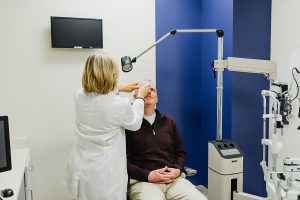


Tears are the body’s natural defense mechanism and are produced by various glands.
When you blink, the tears spread across the front of the eye, creating a smooth and clear surface that is essential for good vision.
The tear film is made up of three layers:
- Mucin Layer – the thinnest and innermost layer of the tear film. This layer allows the tear film to adhere to the eye and defends against ocular surface damage.
- Water Layer – makes up most of what we know as “tears.” It is produced by the lacrimal glands and helps wash away particles and foreign bodies that do not belong in the eye.
- Oil Layer – produced by the meibomian glands. This layer helps to maintain a smooth tear film and prevents the tears from evaporating from the ocular surface too quickly.
Dry eye is a multifactorial disease of the ocular surface. The tear film has lost its normal stability due to inflammation, damage, and/or an abnormal amount of aprticles within the tears. This will lead the eyes to either not produce enough tears or to not produce the right type of tears.
Symptoms:
- Your eyes feel scratchy or gritty, or like there is something in them.
- Your eyes sting and burn, or feel irritated.
- Your eyes water and tear frequently. This sounds like the opposite of dry eye, but the eyes produce more tears in response to an unhealthy and/or abnormalocular surface.
- Your eyes look red or bloodshot.
- Your vision is blurry from time to time and blinking rapidly helps to clear things up.
- It is painful or uncomfortable for you to wear contact lenses.
- There is mucus or “sleep” in and around your eyes.
During your annual in-office eye examination, your optometrist will examine your eyelids, your blink, and the surface of your eyes. Tests may be done to assess the amount and the quality of your tears. This will determine the health of your ocular surface.
- Looking at a computer or focusing on near work (reading) for long periods of time, which is associated with a reduced rate of blinking
- Age – tear production decreases and the meibomian glands become more abnormal.
- Menopause and other hormonal changes
- Long-term contact lens wear
- A history of eye surgery, like refractive surgery (LASIK) or cataract surgery
- Environmental causes:
- Wind
- Smoke
- Dry climate/weather
- Systemic diseases:
- Rheumatoid arthritis
- Thyroid disease
- Lupus
- Sjogren’s syndrome
- Eyelid disorders:
- Blepharitis – swollen/red eyelids
- Entropion – eyelids turned in
- Ectropion – eyelids turned out
- Medicines:
- Some allergy medications (antihistamines)
- Oral contraceptives (birth control pills)
- Some sleeping pills
- Some anxiety medications
- Some high blood pressure medications
- Artificial tear eye drops – if using more than 4 drops per day, you should use preservative-free drops to avoid the irritation that can result from frequent use of drops containing preservatives. Thicker gel drops or ointments may be used at night.
- Warm compresses followed by gentle eyelid massage – encourage healthy meibomian glands
- Eyelid cleaners – remove excess dead skin and over-growth of the natural bacteria along the eyelashes
- Nutritional supplements – omega-3 fatty acids, flaxseed oil, chia seeds to encourage tear production and improve maibomian gland secretion
- Punctal plugs – plugs that block the tear drainage ducts so your natural tears stay on the eye longer
- Steroid eye drops – to reduce inflammation on the ocular surface
- Cyclosporine eye drops – increase the eye’s natural ability to produce tears
